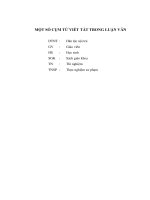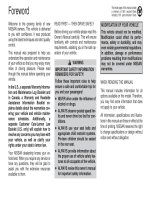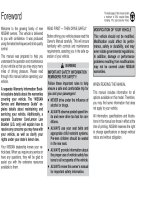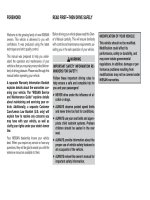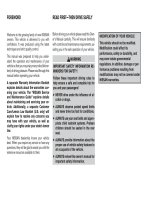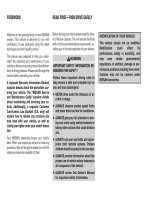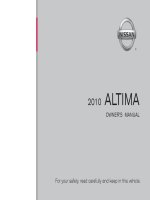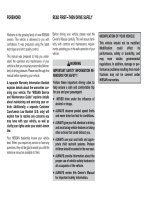AT hộp số tự ĐỘNG, cầu NISSAN ALTIMA 2003
Bạn đang xem bản rút gọn của tài liệu. Xem và tải ngay bản đầy đủ của tài liệu tại đây (10.25 MB, 384 trang )
AT-1
AUTOMATIC TRANSAXLE
C TRANSMISSION/TRANSAXLE
CONTENTS
D
E
F
G
H
I
J
K
L
M
SECTION
A
B
AT
Revision: May 2004 2003 Altima
TROUBLE DIAGNOSIS - INDEX 5
Alphabetical & P No. Index for DTC 5
PRECAUTIONS 7
Precautions for Supplemental Restraint System
(SRS) “AIR BAG” and “SEAT BELT PRE-TEN-
SIONER” 7
Precautions for On Board Diagnostic (OBD) System
of A/T and Engine 7
Precautions 7
Service Notice or Precautions 9
Wiring Diagrams and Trouble Diagnosis 10
PREPARATION 11
Special Service Tools 11
Commercial Service Tools 14
OVERALL SYSTEM 15
A/T Electrical Parts Location 15
Circuit Diagram 16
Cross-sectional View 17
Hydraulic Control Circuit 18
Shift Mechanism 19
Control System 28
Control Mechanism 30
Control Valve 34
ON BOARD DIAGNOSTIC SYSTEM DESCRIP-
TION 36
Introduction 36
OBD-II Function for A/T System 36
One or Two Trip Detection Logic of OBD-II 36
OBD-II Diagnostic Trouble Code (DTC) 36
Malfunction Indicator Lamp (MIL) 40
CONSULT-II 40
Diagnostic Procedure Without CONSULT-II 50
TROUBLE DIAGNOSIS - INTRODUCTION 55
Introduction 55
Work Flow 59
TROUBLE DIAGNOSIS - BASIC INSPECTION 61
A/T Fluid Check 61
Stall Test 61
Line Pressure Test 65
Road Test 66
TROUBLE DIAGNOSIS - GENERAL DESCRIP-
TION 82
Symptom Chart 82
TCM Terminals and Reference Value 92
CAN Communication 95
TROUBLE DIAGNOSIS FOR POWER SUPPLY 100
Wiring Diagram — AT — MAIN 100
Diagnostic Procedure 101
DTC P0705 PARK/NEUTRAL POSITION SWITCH .103
Description 103
On Board Diagnosis Logic 103
Possible Cause 103
Diagnostic Trouble Code (DTC) Confirmation Pro-
cedure 103
Wiring Diagram — AT — PNP/SW 105
Diagnostic Procedure 106
DTC P0710 A/T FLUID TEMPERATURE SENSOR
CIRCUIT 109
Description 109
On Board Diagnosis Logic 109
Possible Cause 109
Diagnostic Trouble Code (DTC) Confirmation Pro-
cedure 109
Wiring Diagram — AT — FTS 111
Diagnostic Procedure 113
DTC P0720 VEHICLE SPEED SENSOR·A/T (REV-
OLUTION SENSOR) 115
Description 115
On Board Diagnosis Logic 115
Possible Cause 115
Diagnostic Trouble Code (DTC) Confirmation Pro-
cedure 115
Wiring Diagram — AT — VSSA/T 117
Diagnostic Procedure 118
DTC P0725 ENGINE SPEED SIGNAL 120
Description 120
On Board Diagnosis Logic 120
Possible Cause 120
Diagnostic Trouble Code (DTC) Confirmation Pro-
cedure 120
AT-2
Revision: May 2004 2003 Altima
Wiring Diagram — AT — ENGSS 121
Diagnostic Procedure 122
DTC P0731 A/T 1ST GEAR FUNCTION 124
Description 124
On Board Diagnosis Logic 124
Possible Cause 124
Diagnostic Trouble Code (DTC) Confirmation Pro-
cedure 124
Wiring Diagram — AT — 1ST 126
Diagnostic Procedure 127
DTC P0732 A/T 2ND GEAR FUNCTION 129
Description 129
On Board Diagnosis Logic 129
Possible Cause 129
Diagnostic Trouble Code (DTC) Confirmation Pro-
cedure 129
Wiring Diagram — AT — 2ND 131
Diagnostic Procedure 132
DTC P0733 A/T 3RD GEAR FUNCTION 134
Description 134
On Board Diagnosis Logic 134
Possible Cause 134
Diagnostic Trouble Code (DTC) Confirmation Pro-
cedure 134
Wiring Diagram — AT — 3RD 136
Diagnostic Procedure 137
DTC P0734 A/T 4TH GEAR FUNCTION 139
Description 139
On Board Diagnosis Logic 139
Possible Cause 139
Diagnostic Trouble Code (DTC) Confirmation Pro-
cedure 139
Wiring Diagram — AT — 4TH 141
Diagnostic Procedure 142
DTC P0740 TORQUE CONVERTER CLUTCH
SOLENOID VALVE 146
Description 146
On Board Diagnosis Logic 146
Possible Cause 146
Diagnostic Trouble Code (DTC) Confirmation Pro-
cedure 146
Wiring Diagram — AT — TCV 148
Diagnostic Procedure 149
DTC P0744 A/T TCC S/V FUNCTION (LOCK-UP) .151
Description 151
On Board Diagnosis Logic 151
Possible Cause 151
Diagnostic Trouble Code (DTC) Confirmation Pro-
cedure 151
Wiring Diagram — AT — TCCSIG 153
Diagnostic Procedure 154
DTC P0745 LINE PRESSURE SOLENOID VALVE .159
Description 159
On Board Diagnosis Logic 159
Possible Cause 159
Diagnostic Trouble Code (DTC) Confirmation Pro-
cedure 159
Wiring Diagram — AT — LPSV 161
Diagnostic Procedure 162
DTC P0750 SHIFT SOLENOID VALVE A 165
Description 165
On Board Diagnosis Logic 165
Possible Cause 165
Diagnostic Trouble Code (DTC) Confirmation Pro-
cedure 165
Wiring Diagram — AT — SSV/A 167
Diagnostic Procedure 168
DTC P0755 SHIFT SOLENOID VALVE B 170
Description 170
On Board Diagnosis Logic 170
Possible Cause 170
Diagnostic Trouble Code (DTC) Confirmation Pro-
cedure 170
Wiring Diagram — AT — SSV/B 172
Diagnostic Procedure 173
DTC P1705 THROTTLE POSITION SENSOR
[ACCELERATOR PEDAL POSITION (APP) SEN-
SOR] 175
Description 175
On Board Diagnosis Logic 176
Possible Cause 176
Diagnostic Trouble Code (DTC) Confirmation Pro-
cedure 176
Wiring Diagram — AT — TPS 178
Diagnostic Procedure 179
DTC P1760 OVERRUN CLUTCH SOLENOID
VALVE 181
Description 181
On Board Diagnosis Logic 181
Possible Cause 181
Diagnostic Trouble Code (DTC) Confirmation Pro-
cedure 181
Wiring Diagram — AT — OVRCSV 183
Diagnostic Procedure 184
DTC U1000 CAN COMMUNICATION LINE 186
Description 186
On Board Diagnosis Logic 186
Possible Cause 186
DTC Confirmation Procedure 186
Wiring Diagram — AT — CAN 187
Diagnostic Procedure 188
DTC BATT/FLUID TEMP SEN (A/T FLUID TEMP
SENSOR CIRCUIT AND TCM POWER SOURCE) .189
Description 189
On Board Diagnosis Logic 189
Possible Cause 189
Diagnostic Trouble Code (DTC) Confirmation Pro-
cedure 189
Wiring Diagram — AT — BA/FTS 191
Diagnostic Procedure 192
DTC VEHICLE SPEED SENSOR MTR 196
Description 196
On Board Diagnosis Logic 196
Possible Cause 196
Diagnostic Trouble Code (DTC) Confirmation Pro-
cedure 196
Wiring Diagram — AT — VSSMTR 198
Diagnostic Procedure 199
AT-3
D
E
F
G
H
I
J
K
L
M
A
B
AT
Revision: May 2004 2003 Altima
DTC TURBINE REVOLUTION SENSOR 200
Description 200
Wiring Diagram — AT — TRSA/T 202
Diagnostic Procedure 203
Component Inspection 204
DTC CONTROL UNIT (RAM), CONTROL UNIT
(ROM) 205
Description 205
On Board Diagnosis Logic 205
Possible Cause 205
Diagnostic Trouble Code (DTC) Confirmation Pro-
cedure 205
Diagnostic Procedure 206
DTC CONTROL UNIT (EEP ROM) 207
Description 207
Diagnostic Procedure 208
TROUBLE DIAGNOSIS FOR SYMPTOMS 209
Wiring Diagram — AT — NONDTC 209
1. A/T Check (Position) Indicator Lamp Does Not
Come On 213
2. Engine Cannot Be Started In P and N Position . 215
3. In P Position, Vehicle Moves Forward or Back-
ward When Pushed 216
4. In N Position, Vehicle Moves 217
5. Large Shock. N → R Position 219
6. Vehicle Does Not Creep Backward In R Position . 221
7. Vehicle Does Not Creep Forward in D, 3, 2 or 1
Position 224
8. Vehicle Cannot Be Started From D
1 227
9. A/T Does Not Shift: D
1 → D2 or Does Not Kick-
down: D
4 → D2 230
10. A/T Does Not Shift: D
2 → D3 233
11. A/T Does Not Shift: D
3 → D4 236
12. A/T Does Not Perform Lock-up 239
13. A/T Does Not Hold Lock-up Condition 241
14. Lock-up Is Not Released 243
15. Engine Speed Does Not Return To Idle (Light
Braking D
4 → D3 ) 244
16. Vehicle Does Not Start From D
1 246
17. A/T Does Not Shift: D
4 → 3 3 , When A/T Selector
Lever D → 3 247
18. A/T Does Not Shift: 3
3 → 22 , When Selector
Lever 3 → 2 Position 248
19. A/T Does Not Shift: 2
2 → 11 , When Selector
Lever 2 → 1 Position 249
20. Vehicle Does Not Decelerate By Engine Brake . 250
21. TCM Self-diagnosis Does Not Activate (PNP &
3 Position Switches Circuit Checks), and Throttle
Position Sensor [Accelerator Pedal Position (APP)
Sensor] Circuit Check 250
A/T SHIFT LOCK SYSTEM 256
Description 256
Shift Lock System Electrical Parts Location 256
Wiring Diagram — SHIFT — 257
Shift Lock Control Unit Reference Values 259
Component Inspection 259
SHIFT CONTROL SYSTEM 262
Control Device 262
Control Cable 263
ON-VEHICLE SERVICE 264
Control Valve Assembly and Accumulators 264
Revolution Sensor Replacement 266
Turbine Revolution Sensor Replacement 266
Park/Neutral Position (PNP) Switch Adjustment 266
Control Cable Adjustment 267
Differential Side Oil Seal Replacement 267
REMOVAL AND INSTALLATION 269
Removal 269
Installation 270
OVERHAUL 272
Components 272
Oil Channel 275
Locations of Adjusting Shims, Needle Bearings,
Thrust Washers and Snap Rings 276
DISASSEMBLY 277
Disassembly 277
REPAIR FOR COMPONENT PARTS 292
Manual Shaft 292
Oil Pump 295
Control Valve Assembly 299
Control Valve Upper Body 307
Control Valve Lower Body 311
Reverse Clutch 314
High Clutch 317
Forward and Overrun Clutches 322
Low & Reverse Brake 328
Rear Internal Gear, Forward Clutch Hub and Over-
run Clutch Hub 331
Output Shaft, Idler Gear, Reduction Pinion Gear and
Bearing Retainer 335
Band Servo Piston Assembly 340
Final Drive 345
ASSEMBLY 350
Assembly (1) 350
Adjustment (1) 351
Assembly (2) 356
Adjustment (2) 363
Assembly (3) 366
SERVICE DATA AND SPECIFICATIONS (SDS) 373
General Specifications 373
Shift Schedule 373
Stall Revolution 374
Line Pressure 374
Control Valves 374
Accumulator 375
Clutch and Brakes 376
Final Drive 378
Planetary Carrier and Oil Pump 379
Input Shaft 379
Reduction Pinion Gear 380
Band Servo 380
Output Shaft 381
Bearing Retainer 381
Total End Play 381
Reverse Clutch End Play 381
Removal and Installation 382
Shift Solenoid Valves 382
Solenoid Valves 382
AT-4
Revision: May 2004 2003 Altima
A/T Fluid Temperature Sensor 382
Revolution Sensor 382
Dropping Resistor 382
Turbine Revolution Sensor 383
TROUBLE DIAGNOSIS - INDEX
AT-5
D
E
F
G
H
I
J
K
L
M
A
B
AT
Revision: May 2004 2003 Altima
TROUBLE DIAGNOSIS - INDEX PFP:00000
Alphabetical & P No. Index for DTC
ECS0069X
ALPHABETICAL INDEX FOR DTC
*1: These numbers are prescribed by SAE J2012.
*2: When the fail-safe operation occurs, the MIL illuminates.
*3: The MIL illuminates when both the “Revolution sensor signal” and the “Vehicle speed sensor signal” meet the fail-safe condition at
the same time.
Items
(CONSULT-II screen terms)
DTC
Reference page
CONSULT-II
GST*1
A/T 1ST GR FNCTN P0731 AT-124
A/T 2ND GR FNCTN P0732 AT-129
A/T 3RD GR FNCTN P0733 AT-134
A/T 4TH GR FNCTN P0734 AT-139
A/T TCC S/V FNCTN P0744 AT-151
ATF TEMP SEN/CIRC P0710 AT-109
ENGINE SPEED SIG P0725 AT-120
L/PRESS SOL/CIRC P0745 AT-159
O/R CLTCH SOL/CIRC P1760 AT-181
PNP SW/CIRC P0705 AT-103
SFT SOL A/CIRC*2 P0750 AT-165
SFT SOL B/CIRC*2 P0755 AT-170
TCC SOLENOID/CIRC P0740 AT-146
TP SEN/CIRC A/T*2 P1705 AT-175
VEH SPD SEN/CIR AT*3 P0720 AT-115
CAN COMM CIRCUIT U1000 AT-186
AT-6
TROUBLE DIAGNOSIS - INDEX
Revision: May 2004 2003 Altima
P NO. INDEX FOR DTC
*1: These numbers are prescribed by SAE J2012.
*2: When the fail-safe operation occurs, the MIL illuminates.
*3: The MIL illuminates when both the “Revolution sensor signal” and the “Vehicle speed sensor signal” meet the fail-safe condition at
the same time.
DTC
Items
(CONSULT-II screen terms)
Reference page
CONSULT-II
GST*1
P0705 PNP SW/CIRC AT-103
P0710 ATF TEMP SEN/CIRC AT-109
P0720 VEH SPD SEN/CIR AT*3 AT-115
P0725 ENGINE SPEED SIG AT-120
P0731 A/T 1ST GR FNCTN AT-124
P0732 A/T 2ND GR FNCTN AT-129
P0733 A/T 3RD GR FNCTN AT-134
P0734 A/T 4TH GR FNCTN AT-139
P0740 TCC SOLENOID/CIRC AT-146
P0744 A/T TCC S/V FNCTN AT-151
P0745 L/PRESS SOL/CIRC AT-159
P0750 SFT SOL A/CIRC*2 AT-165
P0755 SFT SOL B/CIRC*2 AT-170
P1705 TP SEN/CIRC A/T*2 AT-175
P1760 O/R CLTCH SOL/CIRC AT-181
U1000 CAN COMM CIRCUIT AT-186
PRECAUTIONS
AT-7
D
E
F
G
H
I
J
K
L
M
A
B
AT
Revision: May 2004 2003 Altima
PRECAUTIONS PFP:00001
Precautions for Supplemental Restraint System (SRS) “AIR BAG” and “SEAT
BELT PRE-TENSIONER”
ECS006HC
The Supplemental Restraint System such as “AIR BAG” and “SEAT BELT PRE-TENSIONER”, used along
with a front seat belt, helps to reduce the risk or severity of injury to the driver and front passenger for certain
types of collision. This system includes seat belt switch inputs and dual stage front air bag modules. The SRS
system uses the seat belt switches to determine the front air bag deployment, and may only deploy one front
air bag, depending on the severity of a collision and whether the front occupants are belted or unbelted.
Information necessary to service the system safely is included in the SRS and SB section of this Service Man-
ual.
WARNING:
● To avoid rendering the SRS inoperative, which could increase the risk of personal injury or death
in the event of a collision which would result in air bag inflation, all maintenance must be per-
formed by an authorized NISSAN/INFINITI dealer.
● Improper maintenance, including incorrect removal and installation of the SRS, can lead to per-
sonal injury caused by unintentional activation of the system. For removal of Spiral Cable and Air
Bag Module, see the SRS section.
● Do not use electrical test equipment on any circuit related to the SRS unless instructed to in this
Service Manual. SRS wiring harnesses can be identified by yellow and/or orange harness connec-
tors.
Precautions for On Board Diagnostic (OBD) System of A/T and Engine
ECS0069Z
The ECM has an on board diagnostic system. It will light up the malfunction indicator lamp (MIL) to warn the
driver of a malfunction causing emission deterioration.
CAUTION:
● Be sure to turn the ignition switch OFF and disconnect the negative battery terminal before any
repair or inspection work. The open/short circuit of related switches, sensors, solenoid valves,
etc. will cause the MIL to light up.
● Be sure to connect and lock the connectors securely after work. A loose (unlocked) connector will
cause the MIL to light up due to an open circuit. (Be sure the connector is free from water, grease,
dirt, bent terminals, etc.)
● Be sure to route and secure the harnesses properly after work. Interference of the harness with a
bracket, etc. may cause the MIL to light up due to a short circuit.
● Be sure to connect rubber tubes properly after work. A misconnected or disconnected rubber tube
may cause the MIL to light up due to a malfunction of the EGR system or fuel injection system, etc.
● Be sure to erase the unnecessary malfunction information (repairs completed) from the TCM or
ECM before returning the vehicle to the customer.
Precautions
ECS006A0
● Before connecting or disconnecting the TCM harness con-
nector, turn ignition switch OFF and disconnect negative
battery terminal. Failure to do so may damage the TCM.
Because battery voltage is applied to TCM even if ignition
switch is turned off.
SEF289H
AT-8
PRECAUTIONS
Revision: May 2004 2003 Altima
● When connecting or disconnecting pin connectors into or
from TCM, take care not to damage pin terminals (bend or
break).
Make sure that there are not any bends or breaks on TCM
pin terminal, when connecting pin connectors.
● Before replacing TCM, perform TCM input/output signal
inspection and make sure whether TCM functions properly
or not. Refer to AT-29, "
INPUT/OUTPUT SIGNAL OF TCM" .
● After performing each TROUBLE DIAGNOSIS, perform
“DTC (Diagnostic Trouble Code) CONFIRMATION PROCE-
DURE”.
The DTC should not be displayed in the “DTC CONFIRMA-
TION PROCEDURE” if the repair is completed.
● Before proceeding with disassembly, thoroughly clean the out-
side of the transaxle. It is important to prevent the internal parts
from becoming contaminated by dirt or other foreign matter.
● Disassembly should be done in a clean work area.
● Use lint-free cloth or towels for wiping parts clean. Common
shop rags can leave fibers that could interfere with the operation
of the transaxle.
● Place disassembled parts in order for easier and proper assembly.
● All parts should be carefully cleaned with a general purpose, non-flammable solvent before inspection or
reassembly.
● Gaskets, seals and O-rings should be replaced any time the transaxle is disassembled.
● It is very important to perform functional tests whenever they are indicated.
● The valve body contains precision parts and requires extreme care when parts are removed and serviced.
Place disassembled valve body parts in order for easier and proper assembly. Care will also prevent
springs and small parts from becoming scattered or lost.
● Properly installed valves, sleeves, plugs, etc. will slide along bores in valve body under their own weight.
● Before assembly, apply a coat of recommended ATF to all parts. Apply petroleum jelly to protect O-rings
and seals, or hold bearings and washers in place during assembly. Do not use grease.
● Extreme care should be taken to avoid damage to O-rings, seals and gaskets when assembling.
● Replace ATF cooler if excessive foreign material is found in oil pan or clogging strainer. Refer to AT-9,
"ATF COOLER SERVICE" .
● After overhaul, refill the transaxle with new ATF.
● When the A/T drain plug is removed, only some of the fluid is drained. Old A/T fluid will remain in torque
converter and ATF cooling system.
Always follow the procedures when changing A/T fluid. Refer to MA-30, "
Changing A/T Fluid" .
AAT470A
MEF040DA
SAT964I
PRECAUTIONS
AT-9
D
E
F
G
H
I
J
K
L
M
A
B
AT
Revision: May 2004 2003 Altima
Service Notice or Precautions
ECS006A1
FAIL-SAFE
The TCM has an electronic Fail-Safe (limp home mode). This allows the vehicle to be driven even if a major
electrical input/output device circuit is damaged.
Under Fail-Safe, the vehicle always runs in third gear, even with a shift lever position of 1, 2 or D. The cus-
tomer may complain of sluggish or poor acceleration.
When the ignition key is turned ON following Fail-Safe operation, A/T check (position) indicator lamp blinks for
about 8 seconds. [For “TCM Self-diagnostic Procedure (No Tools)”, refer to AT-51, "
TCM SELF-DIAGNOSTIC
PROCEDURE (NO TOOLS)" .]
The blinking of the A/T check (position) indicator lamp for about 8 seconds will appear only once and be
cleared. The customer may resume normal driving conditions.
Always follow the “Work Flow” (Refer to AT-59, "
Work Flow" ).
The SELF-DIAGNOSIS results will be as follows:
● The first SELF-DIAGNOSIS will indicate damage to the vehicle speed sensor or the revolution sensor.
● During the next SELF-DIAGNOSIS, performed after checking the sensor, no damages will be indicated.
TORQUE CONVERTER SERVICE
The torque converter should be replaced under any of the following conditions:
● External leaks in the hub weld area.
● Converter hub is scored or damaged.
● Converter pilot is broken, damaged or fits poorly into crankshaft.
● Steel particles are found after flushing the cooler and cooler lines.
● Pump is damaged or steel particles are found in the converter.
● Vehicle has TCC shudder and/or no TCC apply. Replace only after all hydraulic and electrical diagnoses
have been made. (Converter clutch material may be glazed.)
● Converter is contaminated with engine coolant containing antifreeze.
● Internal failure of stator roller clutch.
● Heavy clutch debris due to overheating (blue converter).
● Steel particles or clutch lining material found in fluid filter or on magnet when no internal parts in unit are
worn or damaged — indicates that lining material came from converter.
The torque converter should not be replaced if:
● The fluid has an odor, is discolored, and there is no evidence of metal or clutch facing particles.
● The threads in one or more of the converter bolt holes are damaged.
● Transaxle failure did not display evidence of damaged or worn internal parts, steel particles or clutch plate
lining material in unit and inside the fluid filter.
● Vehicle has been exposed to high mileage (only). The exception may be where the torque converter
clutch dampener plate lining has seen excess wear by vehicles operated in heavy and/or constant traffic,
such as taxi, delivery or police use.
ATF COOLER SERVICE
If A/T fluid contains frictional material (clutches, bands, etc.), replace radiator and flush cooler line using clean-
ing solvent and compressed air after repair of A/T. Refer to CO-10, "
RADIATOR" (with QR25DE), or CO-31,
"RADIATOR" (with VQ35DE).
OBD-II SELF-DIAGNOSIS
● A/T self-diagnosis is performed by the TCM in combination with the ECM. The results can be read through
the blinking pattern of the A/T check (position) indicator or the malfunction indicator lamp (MIL). Refer to
the table on AT-41
for the indicator used to display each self-diagnostic result.
● The self-diagnostic results indicated by the MIL are automatically stored in both the ECM and TCM mem-
ories.
Always perform the procedure “HOW TO ERASE DTC” on AT-38
to complete the repair and avoid
unnecessary blinking of the MIL.
● The following self-diagnostic items can be detected using ECM self-diagnostic results mode* only when
the A/T check (position) indicator lamp does not indicate any malfunctions.
– park/neutral position (PNP) switch
– A/T 1st, 2nd, 3rd, or 4th gear function
AT-10
PRECAUTIONS
Revision: May 2004 2003 Altima
– A/T TCC S/V function (lock-up).
*: For details of OBD-II, refer to EC-53, "
ON BOARD DIAGNOSTIC (OBD) SYSTEM" (with QR25DE), or
EC-677, "
ON BOARD DIAGNOSTIC (OBD) SYSTEM" (with VQ35DE).
● Certain systems and components, especially those related to OBD, may use a new style slide-
locking type harness connector.
For description and how to disconnect, refer to GI-22, "
How to Check Terminal" .
Wiring Diagrams and Trouble Diagnosis
ECS006A2
When you read wiring diagrams, refer to the following:
● GI-12, "How to Read Wiring Diagrams"
● PG-3, "POWER SUPPLY ROUTING CIRCUIT"
When you perform trouble diagnosis, refer to the following:
● GI-10, "HOW TO FOLLOW TEST GROUPS IN TROUBLE DIAGNOSES"
● GI-25, "How to Perform Efficient Diagnosis for an Electrical Incident"
PREPARATION
AT-11
D
E
F
G
H
I
J
K
L
M
A
B
AT
Revision: May 2004 2003 Altima
PREPARATION PFP:00002
Special Service Tools
ECS006A3
The actual shapes of Kent-Moore tools may differ from those of special service tools illustrated here.
Tool number
(Kent-Moore No.)
Tool name
Description
KV381054S0
(J34286)
Puller
● Removing differential side oil seals
● Removing differential side bearing outer
race
● Removing idler gear bearing outer race
a: 250 mm (9.84 in)
b: 160 mm (6.30 in)
ST33400001
(J26082)
Drift
● Installing differential side oil seal
(RH side)
● Installing oil seal on oil pump housing
a: 60 mm (2.36 in) dia.
b: 47 mm (1.85 in) dia.
(J34301-C)
Oil pressure gauge set
1 (J34301-1)
Oil pressure gauge
2 (J34301-2)
Hoses
3 (J34298)
Adapter
4 (J34282-2)
Adapter
5 (790-301-1230-A)
60° Adapter
6 (J34301-15)
Square socket
● Measuring line pressure
ST27180001
(J25726-A)
Puller
● Removing idler gear
a: 100 mm (3.94 in)
b: 110 mm (4.33 in)
c: M8 x 1.25P
ST23540000
(J25689-A)
Pin punch
● Removing and installing parking rod plate
and manual plate pins
a: 2.3 mm (0.091 in) dia.
b: 4 mm (0.16 in) dia.
ST25710000
(J25689-A)
Pin punch
● Aligning groove of manual shaft and hole of
transmission case
a: 2 mm (0.08 in) dia.
NT414
NT086
AAT896
NT424
NT442
NT410
AT-12
PREPARATION
Revision: May 2004 2003 Altima
KV32101000
(J25689-A)
Pin punch
● Removing and installing manual shaft re-
taining pin
● Removing and installing pinion mate shaft
lock pin
a: 4 mm (0.16 in) dia.
KV31102400
(J34285 and J34285-87)
Clutch spring compressor
● Removing and installing clutch return
springs
● Installing low and reverse brake piston
a: 320 mm (12.60 in)
b: 174 mm (6.85 in)
KV40100630
(J26092)
Drift
● Installing reduction gear bearing inner race
● Installing idler gear bearing inner race
a: 67.5 mm (2.657 in) dia.
b: 44 mm (1.73 in) dia.
c: 38.5 mm (1.516 in) dia.
ST30720000
(J25405 and J34331)
Bearing installer
● Installing idler gear bearing outer race
a: 77 mm (3.03 in) dia.
b: 55.5 mm (2.185 in) dia.
ST35321000
( — )
Drift
● Installing output shaft bearing
a: 49 mm (1.93 in) dia.
b: 41 mm (1.61 in) dia.
(J34291-A)
Shim setting gauge set
● Selecting oil pump cover bearing race and
oil pump thrust washer
● Selecting side gear thrust washer
ST33230000
(J25805-01)
Drift
● Installing differential side bearing inner race
(RH side)
a: 51 mm (2.01 in) dia.
b: 28.5 mm (1.122 in) dia.
Tool number
(Kent-Moore No.)
Tool name
Description
NT410
NT423
NT107
NT115
NT073
NT101
NT084
PREPARATION
AT-13
D
E
F
G
H
I
J
K
L
M
A
B
AT
Revision: May 2004 2003 Altima
(J34290)
Shim selecting tool set
● Selecting differential side bearing adjusting
shim
ST3306S001
(J22888-D)
Differential side bearing puller set
1 ST33051001
(J22888-D)
Puller
2 ST33061000
(J8107-2)
Adapter
● Removing differential side bearing inner
race
a: 38 mm (1.50 in) dia.
b: 28.5 mm (1.122 in) dia.
c: 130 mm (5.12 in)
d: 135 mm (5.31 in)
e: 100 mm (3.94 in)
ST3127S000
(J25765-A)
Preload gauge
1 GG91030000
(J25765-A)
Torque wrench
2 HT62940000
( — )
Socket adapter
3 HT62900000
( — )
Socket adapter
● Checking differential side bearing preload
ST35271000
(J26091)
Drift
● Installing idler gear
a: 72 mm (2.83 in) dia.
b: 63 mm (2.48 in) dia.
(J39713)
Preload adapter
● Selecting differential side bearing adjusting
shim
● Checking differential side bearing preload
(J45816)
E20 TORX socket
● Removing flex plate bolts on vehicles
equipped with QR25DE engines.
Tool number
(Kent-Moore No.)
Tool name
Description
NT080
AMT153
NT124
NT115
NT087
LCIA0258E
AT-14
PREPARATION
Revision: May 2004 2003 Altima
Commercial Service Tools
ECS006A4
Tool name Description
Puller
● Removing idler gear bearing inner race
● Removing and installing band servo piston
snap ring
Puller
● Removing reduction gear bearing inner
race
a: 60 mm (2.36 in) dia.
b: 35 mm (1.38 in) dia.
Drift
● Installing needle bearing on bearing retain-
er
a: 36 mm (1.42 in) dia.
Drift
● Removing needle bearing from bearing re-
tainer
a: 33.5 mm (1.319 in) dia.
Drift
● Installing differential side bearing outer race
(RH side)
a: 75 mm (2.95 in) dia.
Power tool
● Removing transaxle assembly
● Removing transaxle oil pan
● Removing transaxle case and cover
NT077
NT411
NT083
NT083
NT083
PBIC0190E
OVERALL SYSTEM
AT-15
D
E
F
G
H
I
J
K
L
M
A
B
AT
Revision: May 2004 2003 Altima
OVERALL SYSTEM PFP:00000
A/T Electrical Parts Location
ECS006A5
LCIA0291E
AT-16
OVERALL SYSTEM
Revision: May 2004 2003 Altima
Circuit Diagram
ECS006A6
WCWA0044E
OVERALL SYSTEM
AT-17
D
E
F
G
H
I
J
K
L
M
A
B
AT
Revision: May 2004 2003 Altima
Cross-sectional View
ECS006A7
1. Band servo piston 2. Reverse clutch drum 3. Converter housing
4. Oil pump 5. Brake band 6. Reverse clutch
7. High clutch 8. Front planetary gear 9. Low one-way clutch
10. Rear planetary gear 11. Forward clutch 12. Overrun clutch
13. Low & reverse brake 14. Output gear 15. Idler gear
16. Forward one-way clutch 17. Pinion reduction gear 18. Final gear
19. Differential case 20. Input shaft 21. Torque converter
22. Side cover
SAT488K
AT-18
OVERALL SYSTEM
Revision: May 2004 2003 Altima
Hydraulic Control Circuit
ECS006A8
LCIA0040E
OVERALL SYSTEM
AT-19
D
E
F
G
H
I
J
K
L
M
A
B
AT
Revision: May 2004 2003 Altima
Shift Mechanism
ECS006A9
CONSTRUCTION
FUNCTION OF CLUTCH AND BRAKE
CLUTCH AND BAND CHART
1. Torque converter 2. Oil pump 3. Input shaft
4. Brake band 5. Reverse clutch 6. High clutch
7. Front sun gear 8. Front pinion gear 9. Front internal gear
10. Front planetary carrier 11. Rear sun gear 12. Rear pinion gear
13. Rear internal gear 14. Rear planetary carrier 15. Forward clutch
16. Forward one-way clutch 17. Overrun clutch 18. Low one-way clutch
19. Low & reverse brake 20. Parking pawl 21. Parking gear
22. Output shaft 23. Idle gear 24. Output gear
SAT998I
Clutch and brake components Abbr. Function
Reverse clutch 5 R/C To transmit input power to front sun gear 7 .
High clutch 6 H/C To transmit input power to front planetary carrier 10 .
Forward clutch 15 F/C To connect front planetary carrier 10 with forward one-way clutch
16 .
Overrun clutch 17 O/C To connect front planetary carrier 10 with rear internal gear 13 .
Brake band 4 B/B To lock front sun gear 7 .
Forward one-way clutch 16 F/O.C When forward clutch 15 is engaged, to stop rear internal gear 13
from rotating in opposite direction against engine revolution.
Low one-way clutch 18 L/O.C To stop front planetary carrier 10 from rotating in opposite direc-
tion against engine revolution.
Low & reverse brake 19 L & R/B To lock front planetary carrier 10 .
Shift position
Re-
verse
clutch
5
High
clutch
6
For-
ward
clutch
15
Over-
run
clutch
17
Band servo For-
ward
one-
way
clutch
16
Low
one-
way
clutch
18
Low &
re-
verse
brake
19
Lock-
up
Remarks
2nd
apply
3rd re-
lease
4th
apply
P
PARK POSI-
TION
RO O
REVERSE
POSITION
AT-20
OVERALL SYSTEM
Revision: May 2004 2003 Altima
*1: Operates when selector lever is set in 3 position.
*2: Oil pressure is applied to both 2nd “apply” side and 3rd “release” side of band servo piston. However, brake band does not contract
because oil pressure area on the “release” side is greater than that on the “apply” side.
*3: Oil pressure is applied to 4th “apply” side in condition *2 above, and brake band contracts.
*4: A/T will not shift to 4th when selector lever is set in 3 position.
*5: Operates when selector lever is set in 3 position.
O: Operates
A: Operates when throttle opening is less than 3/16, activating engine brake.
B: Operates during “progressive” acceleration.
C: Operates but does not affect power transmission.
D: Operates when throttle opening is less than 3/16, but does not affect engine brake.
N
NEUTRAL
POSITION
D*4
1st O *1D B B
Automatic
shift
1 ⇔ 2 ⇔ 3
⇔ 4
2nd O *1 A O B
3rd O O *1 A *2C C B *5O
4th O C *3C C O O
2
1st O D B B Automatic
shift
1 ⇔ 2 ⇐ 3
2nd O A O B
1
1st O O B O Locks (held
stationary) in
1st speed
1 ⇐ 2 ⇐ 3
2nd O O O B
Shift position
Re-
verse
clutch
5
High
clutch
6
For-
ward
clutch
15
Over-
run
clutch
17
Band servo For-
ward
one-
way
clutch
16
Low
one-
way
clutch
18
Low &
re-
verse
brake
19
Lock-
up
Remarks
2nd
apply
3rd re-
lease
4th
apply
OVERALL SYSTEM
AT-21
D
E
F
G
H
I
J
K
L
M
A
B
AT
Revision: May 2004 2003 Altima
POWER TRANSMISSION
P and N Positions
● P position
Similar to the N position, the clutches do not operate. The parking pawl engages with the parking gear to
mechanically hold the output shaft so that the power train is locked.
● N position
Power from the input shaft is not transmitted to the output shaft because the clutches do not operate.
SAT991I
AT-22
OVERALL SYSTEM
Revision: May 2004 2003 Altima
11 Position
AAT537A
● Forward clutch
● Forward one-way clutch
● Overrun clutch
● Low and reverse brake
As overrun clutch engages, rear internal gear is locked by the operation of low and reverse
brake.
This is different from that of D
1 , 21 , and 31 .
Engine brake Overrun clutch always engages, therefore engine brake can be obtained when decelerating.
OVERALL SYSTEM
AT-23
D
E
F
G
H
I
J
K
L
M
A
B
AT
Revision: May 2004 2003 Altima
D1 and 21 Positions
AAT532A
● Forward one-way clutch
● Forward clutch
● Low one-way clutch
Rear internal gear is locked to rotate counterclockwise because of the functioning of these
three clutches.
Overrun clutch
engagement conditions
(Engine brake)
D
1 : Overdrive control switch OFF and throttle opening is less than 3/16
2
1 : Always engaged
At D
1 and 21 positions, engine brake is not activated due to free turning of low one-way
clutch.
AT-24
OVERALL SYSTEM
Revision: May 2004 2003 Altima
D2 , 32 , 22 and 12 Positions
AAT533A
● Forward clutch
● Forward one-way clutch
● Brake band
Rear sun gear drives rear planetary carrier and combined front internal gear. Front internal
gear now rotates around front sun gear accompanying front planetary carrier.
As front planetary carrier transfers the power to rear internal gear through forward clutch and
forward one-way clutch, this rotation of rear internal gear increases the speed of rear plane-
tary carrier compared with that of the 1st speed.
Overrun clutch
engagement conditions
3
2 : Gear selector lever is set in 3 position and throttle opening is less than 3/16
3
2 , 22 and 12 : Always engaged
OVERALL SYSTEM
AT-25
D
E
F
G
H
I
J
K
L
M
A
B
AT
Revision: May 2004 2003 Altima
D3 and 33 Positions
AAT534A
● High clutch
● Forward clutch
● Forward one-way clutch
Input power is transmitted to front planetary carrier through high clutch. And front planetary
carrier is connected to rear internal gear by operation of forward clutch and forward one-way
clutch.
This rear internal gear rotation and another input (the rear sun gear) accompany rear plane-
tary carrier to turn at the same speed.
Overrun clutch
engagement conditions
D
3 and 33 : Selector lever is set in 3 position and throttle opening is less than 3/16
